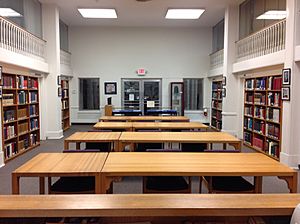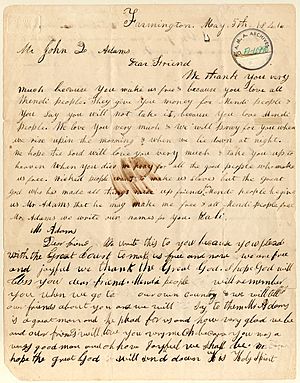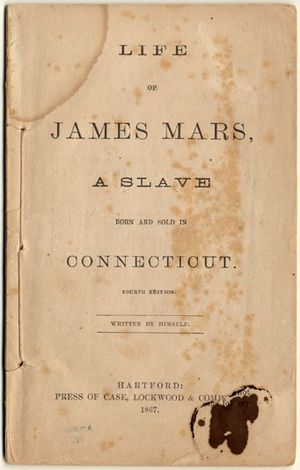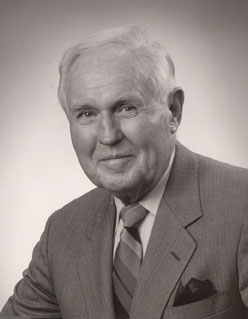Amistad Research Center facts for kids
Quick facts for kids Amistad Research Center |
|
|---|---|
 |
|
| The reading room at the Amistad Research Center | |
| Country | United States |
| Type | Research library and archive |
| Established | 1966 |
| Location | New Orleans, Louisiana |
| Collection | |
| Items collected | Manuscripts, books, and art |
| Size | approx. 15 million |
The Amistad Research Center (ARC) is a special place in the United States. It's like a huge library and museum for old documents. It focuses on the history of African Americans and other ethnic minorities. It was one of the first places to collect records about African American history and the Civil Rights Movement.
The ARC has about 15 million items! These include old papers, books, photos, and amazing artwork. They even have digital copies so people can study from far away. While the ARC mainly focuses on African American history, it also has collections about Latinos, Asian Americans, Native Americans, people from Appalachia, and the LGBTQ community.
Contents
How the Amistad Research Center Started
The Beginning at Fisk University
The story of the ARC goes back to a famous court case in 1841. This case involved a ship called the Amistad. People who helped the Africans on the Amistad later started a group called the American Missionary Association (AMA). This group worked to end slavery and bring people together.
After the United States Civil War, the AMA opened many schools for freedmen (formerly enslaved people) and other groups. These schools included colleges and universities. Over the years, the AMA became part of larger church groups.
In 1942, the AMA created the Race Relations Department at Fisk University in Nashville, Tennessee. This department studied problems of unfair treatment. In 1966, the Amistad Research Center was created within this department. Its job was to keep the AMA's historical records safe.
Clifton H. Johnson became the first director of the ARC in 1966. He was a great choice because he knew a lot about the AMA's history. He had even written his college paper about their records. Johnson wanted the ARC to be a place where scholars could find important documents about African American history. In 1969, the ARC became its own independent, non-profit organization.
Moving to Dillard University
After becoming independent, the ARC needed a new home. Dr. Albert W. Dent, who used to be the president of Dillard University, invited the ARC to move to Dillard.
In 1970, the ARC moved into Dillard University's library. Dillard let them stay for free and even promised land for a new building. However, the money for a new building never came through. The ARC's collections kept growing, and they soon ran out of space at Dillard. So, they had to look for another location.
A New Home at the New Orleans Mint
The Amistad Research Center moved to the New Orleans Mint in 1980. The United States government had given this old building to the state of Louisiana. The state then gave it to the Louisiana State Museum.
Clifton Johnson made a deal with the museum director to rent space for just $1 a year! The ARC spent $500,000 to fix up the new space. They thought it would be big enough for 15 years. But the collections grew even faster than expected. After only five years, the ARC needed more space again. Johnson and the ARC's leaders started looking for another new home.
Finding a Permanent Home at Tulane University
By the mid-1980s, the ARC really needed a bigger place. Many universities wanted to host the ARC, including Harvard University and Tulane University. Some people were worried about moving the center to places like Tulane because of their past history with Black students.
However, many people in New Orleans wanted the ARC to stay in their city. Local supporters gathered hundreds of signatures from Black residents who wanted the ARC at Tulane. Important people like Rosa Keller, Tulane President Eamon Kelly, and New Orleans Mayor Ernest Morial also pushed for the move to Tulane.
Finally, the ARC's board voted to move to Tulane University. The ARC has been on Tulane's campus in Uptown New Orleans since 1987. In 1996, Donald DeVore became the first African American director of the ARC.
What the Amistad Research Center Holds
Archives and Manuscripts


The ARC has about 800 collections of old papers and documents. These show important parts of history, like the Civil Rights Movement, race relations, education, and art. They also have 250,000 photos from as far back as 1860.
The center has nearly 8,000 videos and sound recordings. These include oral histories (recorded interviews) with civil rights activists, community leaders, artists, and musicians. You can also find materials related to famous people like W.E.B. DuBois, Mary McLeod Bethune, Langston Hughes, and Frederick Douglass.
Some of the important papers and records they hold are from:
Library Collection
The ARC's library has many books, newspapers, and other printed materials. These help tell the story of different ethnic groups in the United States. The library has about 45,000 books, including rare and first editions. It also has more than 2,000 different magazines and journals from 1826 onwards.
The library has a great collection of African American literature. It even has books from the personal libraries of authors like Countee Cullen and Chester Himes. A special item is Lewis Tappan's book about the Amistad court case, with his own notes written inside.
Art Collection

The ARC has a wonderful collection of about 400 pieces of African American art. Many of these artworks came from the William E. Harmon Foundation. They show the growth of African American art in the mid-1900s. You can find portraits, landscapes, and other types of paintings. Many of these are available to view online.
Because the ARC doesn't have enough space to show all its art, many pieces are displayed at other big museums. These include the Ogden Museum of Southern Art and the Cleveland Museum of Art.
One of the most famous parts of the collection is the 41 paintings in the Toussaint L'Ouverture series. These were created in 1938 by Jacob Lawrence, a famous American artist. Lawrence was only 21 when he made these paintings. They tell the story of the Haitian Revolution.
Another highlight is Ellis Wilson's oil painting called Funeral Procession. This painting was even featured on a popular TV show in the 1980s.
The ARC's art collection includes works from:
See also


